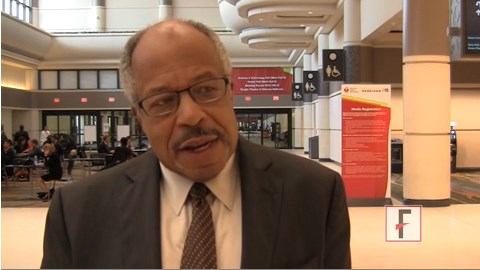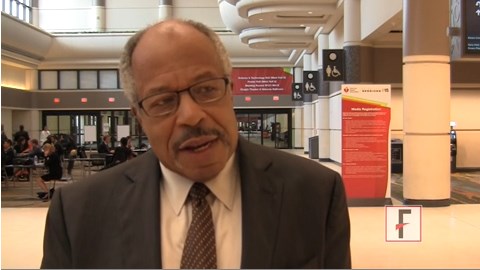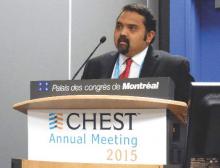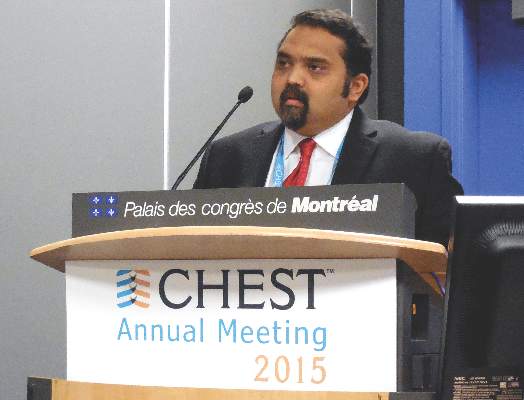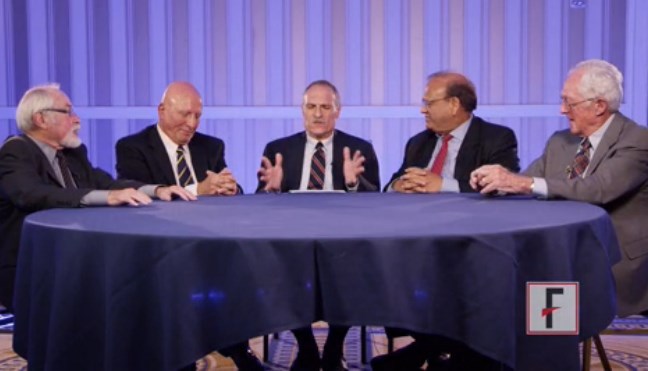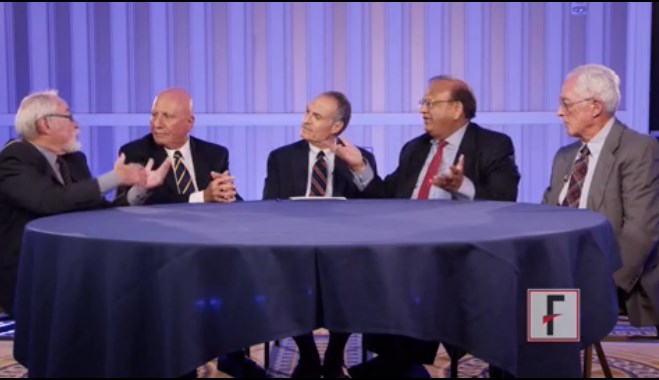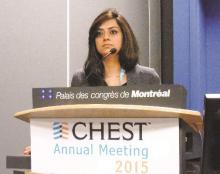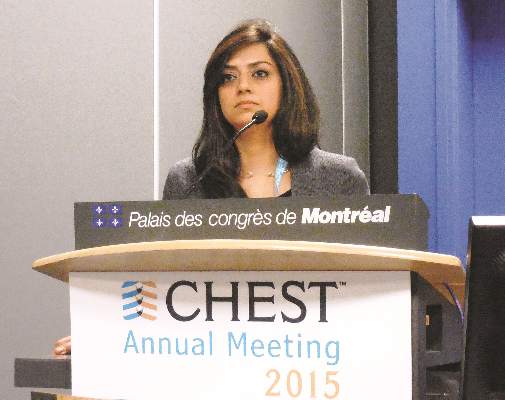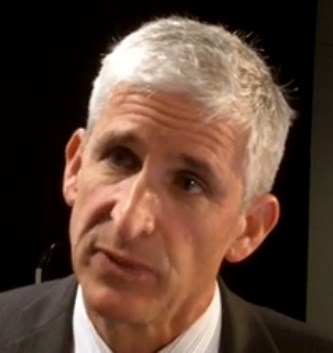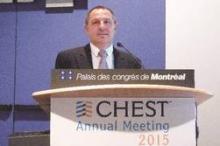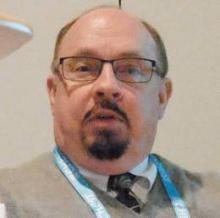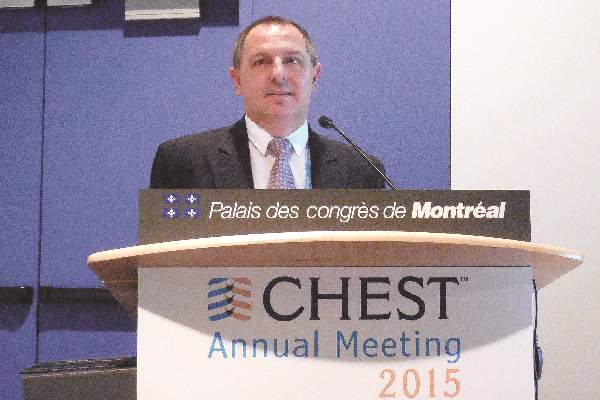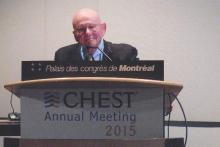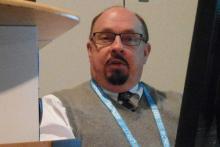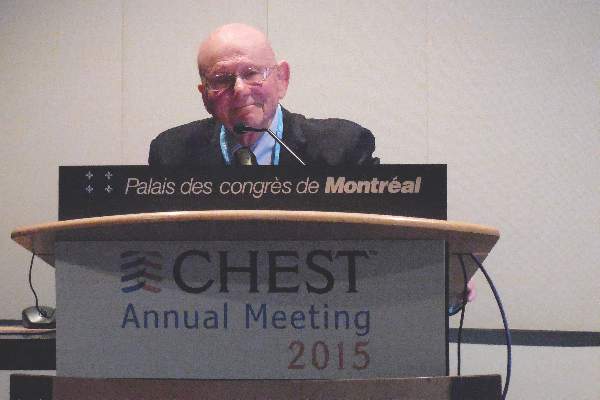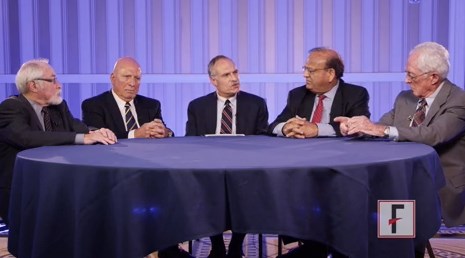User login
Mitchel is a reporter for MDedge based in the Philadelphia area. He started with the company in 1992, when it was International Medical News Group (IMNG), and has since covered a range of medical specialties. Mitchel trained as a virologist at Roswell Park Memorial Institute in Buffalo, and then worked briefly as a researcher at Boston Children's Hospital before pivoting to journalism as a AAAS Mass Media Fellow in 1980. His first reporting job was with Science Digest magazine, and from the mid-1980s to early-1990s he was a reporter with Medical World News. @mitchelzoler
VIDEO: SPRINT Resets Many Patients’ Hypertension Treatment Target
ORLANDO – The paradigm-shifting results from the SPRINT trial showed the added benefit from a new target systolic blood-pressure goal of less than 120 mm Hg for many patients with risk factors for cardiovascular disease, but the results did not address the issue of which systolic blood pressure to use to identify patients who have hypertension and require drug intervention.
“We tested a target of less than 120 mm Hg against a target of less than 140 mm Hg; the question of whom to treat and to whom this applies” did not get tested in SPRINT (Systolic Blood Pressure Intervention Trial), Dr. Jackson T. Wright Jr. said in an interview at the American Heart Association scientific sessions.
“What the trial showed was that treating to a systolic blood pressure of less than 120 mm Hg reduced the primary, combined endpoint by [a relative] 25%, reduced all-cause mortality by [a relative] 27%, and reduced heart failure by [a relative] 38%” compared with patients treated to a target systolic pressure of less than 140 mm Hg, said Dr. Wright, professor and director of the clinical hypertension program at University Hospitals Case Medical Center in Cleveland. Concurrently with the study’s report, the SPRINT results appeared in an article published online (N Engl J Med. 2015;doi:10.1056/NEJMoa1511939).
Dr. Wright acknowledged that the more aggressive antihypertensive regimen used in SPRINT to get patients’ systolic blood pressure to a goal of less than 120 mm Hg resulted in an absolute 2.2% increased rate of serious adverse events attributable to study treatment compared with the control patients treated to a target pressure of less than 140 mm Hg, but he contended that the benefits from lower pressure outweighed this risk. Patients in the more aggressive arm required an average of 2.8 drugs/patient compared with an average of 1.8 antihypertensive drugs used by control patients. The average achieved systolic blood pressure in the aggressive arm was 121.5 mm Hg, and 134.6 mm Hg in the control arm.
Patients enrolled in SPRINT had to be at least 50 years old, have a systolic blood pressure of 130-180 mm Hg, and have an increased risk for cardiovascular disease events. That risk was defined as having at least one of these factors: clinical or subclinical cardiovascular disease other than stroke; chronic kidney disease (but excluding polycystic kidney disease) with an estimated glomerular filtration rate of 20-59 mL/min per 1.73 m2; a 10-year cardiovascular disease risk of at least 15% based on the Framingham risk score; or an age of 75 years or older. The study excluded patients with a history of stroke or diabetes.
Subgroup analyses showed consistent benefit across all subgroups including age, gender, race, the presence or absence of chronic kidney disease, and systolic blood pressure at entry. A third of patients entered the trial with a systolic blood pressure of 132 mm Hg or less. Also at baseline, 91% of enrolled patients had already been receiving antihypertensive drugs. Overall, enrolled patients were receiving an average of 1.8 antihypertensive drugs each when they entered the study.
Patients enrolled in SPRINT received treatment for an average of 3.26 years. The investigators had designed SPRINT to run for 5 years but stopped the trial sooner than planned in August when the study’s data and safety monitoring board identified clear evidence of the superiority of the more aggressive treatment that fulfilled the trials prespecified stopping criterion.
SPRINT received no commercial funding. The study received antihypertensive drugs from Arbor and Takeda at no charge for a small percentage of enrolled patients. Dr. Wright had no disclosures.
The video associated with this article is no longer available on this site. Please view all of our videos on the MDedge YouTube channel
ORLANDO – The paradigm-shifting results from the SPRINT trial showed the added benefit from a new target systolic blood-pressure goal of less than 120 mm Hg for many patients with risk factors for cardiovascular disease, but the results did not address the issue of which systolic blood pressure to use to identify patients who have hypertension and require drug intervention.
“We tested a target of less than 120 mm Hg against a target of less than 140 mm Hg; the question of whom to treat and to whom this applies” did not get tested in SPRINT (Systolic Blood Pressure Intervention Trial), Dr. Jackson T. Wright Jr. said in an interview at the American Heart Association scientific sessions.
“What the trial showed was that treating to a systolic blood pressure of less than 120 mm Hg reduced the primary, combined endpoint by [a relative] 25%, reduced all-cause mortality by [a relative] 27%, and reduced heart failure by [a relative] 38%” compared with patients treated to a target systolic pressure of less than 140 mm Hg, said Dr. Wright, professor and director of the clinical hypertension program at University Hospitals Case Medical Center in Cleveland. Concurrently with the study’s report, the SPRINT results appeared in an article published online (N Engl J Med. 2015;doi:10.1056/NEJMoa1511939).
Dr. Wright acknowledged that the more aggressive antihypertensive regimen used in SPRINT to get patients’ systolic blood pressure to a goal of less than 120 mm Hg resulted in an absolute 2.2% increased rate of serious adverse events attributable to study treatment compared with the control patients treated to a target pressure of less than 140 mm Hg, but he contended that the benefits from lower pressure outweighed this risk. Patients in the more aggressive arm required an average of 2.8 drugs/patient compared with an average of 1.8 antihypertensive drugs used by control patients. The average achieved systolic blood pressure in the aggressive arm was 121.5 mm Hg, and 134.6 mm Hg in the control arm.
Patients enrolled in SPRINT had to be at least 50 years old, have a systolic blood pressure of 130-180 mm Hg, and have an increased risk for cardiovascular disease events. That risk was defined as having at least one of these factors: clinical or subclinical cardiovascular disease other than stroke; chronic kidney disease (but excluding polycystic kidney disease) with an estimated glomerular filtration rate of 20-59 mL/min per 1.73 m2; a 10-year cardiovascular disease risk of at least 15% based on the Framingham risk score; or an age of 75 years or older. The study excluded patients with a history of stroke or diabetes.
Subgroup analyses showed consistent benefit across all subgroups including age, gender, race, the presence or absence of chronic kidney disease, and systolic blood pressure at entry. A third of patients entered the trial with a systolic blood pressure of 132 mm Hg or less. Also at baseline, 91% of enrolled patients had already been receiving antihypertensive drugs. Overall, enrolled patients were receiving an average of 1.8 antihypertensive drugs each when they entered the study.
Patients enrolled in SPRINT received treatment for an average of 3.26 years. The investigators had designed SPRINT to run for 5 years but stopped the trial sooner than planned in August when the study’s data and safety monitoring board identified clear evidence of the superiority of the more aggressive treatment that fulfilled the trials prespecified stopping criterion.
SPRINT received no commercial funding. The study received antihypertensive drugs from Arbor and Takeda at no charge for a small percentage of enrolled patients. Dr. Wright had no disclosures.
The video associated with this article is no longer available on this site. Please view all of our videos on the MDedge YouTube channel
ORLANDO – The paradigm-shifting results from the SPRINT trial showed the added benefit from a new target systolic blood-pressure goal of less than 120 mm Hg for many patients with risk factors for cardiovascular disease, but the results did not address the issue of which systolic blood pressure to use to identify patients who have hypertension and require drug intervention.
“We tested a target of less than 120 mm Hg against a target of less than 140 mm Hg; the question of whom to treat and to whom this applies” did not get tested in SPRINT (Systolic Blood Pressure Intervention Trial), Dr. Jackson T. Wright Jr. said in an interview at the American Heart Association scientific sessions.
“What the trial showed was that treating to a systolic blood pressure of less than 120 mm Hg reduced the primary, combined endpoint by [a relative] 25%, reduced all-cause mortality by [a relative] 27%, and reduced heart failure by [a relative] 38%” compared with patients treated to a target systolic pressure of less than 140 mm Hg, said Dr. Wright, professor and director of the clinical hypertension program at University Hospitals Case Medical Center in Cleveland. Concurrently with the study’s report, the SPRINT results appeared in an article published online (N Engl J Med. 2015;doi:10.1056/NEJMoa1511939).
Dr. Wright acknowledged that the more aggressive antihypertensive regimen used in SPRINT to get patients’ systolic blood pressure to a goal of less than 120 mm Hg resulted in an absolute 2.2% increased rate of serious adverse events attributable to study treatment compared with the control patients treated to a target pressure of less than 140 mm Hg, but he contended that the benefits from lower pressure outweighed this risk. Patients in the more aggressive arm required an average of 2.8 drugs/patient compared with an average of 1.8 antihypertensive drugs used by control patients. The average achieved systolic blood pressure in the aggressive arm was 121.5 mm Hg, and 134.6 mm Hg in the control arm.
Patients enrolled in SPRINT had to be at least 50 years old, have a systolic blood pressure of 130-180 mm Hg, and have an increased risk for cardiovascular disease events. That risk was defined as having at least one of these factors: clinical or subclinical cardiovascular disease other than stroke; chronic kidney disease (but excluding polycystic kidney disease) with an estimated glomerular filtration rate of 20-59 mL/min per 1.73 m2; a 10-year cardiovascular disease risk of at least 15% based on the Framingham risk score; or an age of 75 years or older. The study excluded patients with a history of stroke or diabetes.
Subgroup analyses showed consistent benefit across all subgroups including age, gender, race, the presence or absence of chronic kidney disease, and systolic blood pressure at entry. A third of patients entered the trial with a systolic blood pressure of 132 mm Hg or less. Also at baseline, 91% of enrolled patients had already been receiving antihypertensive drugs. Overall, enrolled patients were receiving an average of 1.8 antihypertensive drugs each when they entered the study.
Patients enrolled in SPRINT received treatment for an average of 3.26 years. The investigators had designed SPRINT to run for 5 years but stopped the trial sooner than planned in August when the study’s data and safety monitoring board identified clear evidence of the superiority of the more aggressive treatment that fulfilled the trials prespecified stopping criterion.
SPRINT received no commercial funding. The study received antihypertensive drugs from Arbor and Takeda at no charge for a small percentage of enrolled patients. Dr. Wright had no disclosures.
The video associated with this article is no longer available on this site. Please view all of our videos on the MDedge YouTube channel
AT THE AHA SCIENTIFIC SESSIONS
VIDEO: SPRINT resets many patients’ hypertension treatment target
ORLANDO – The paradigm-shifting results from the SPRINT trial showed the added benefit from a new target systolic blood-pressure goal of less than 120 mm Hg for many patients with risk factors for cardiovascular disease, but the results did not address the issue of which systolic blood pressure to use to identify patients who have hypertension and require drug intervention.
“We tested a target of less than 120 mm Hg against a target of less than 140 mm Hg; the question of whom to treat and to whom this applies” did not get tested in SPRINT (Systolic Blood Pressure Intervention Trial), Dr. Jackson T. Wright Jr. said in an interview at the American Heart Association scientific sessions.
“What the trial showed was that treating to a systolic blood pressure of less than 120 mm Hg reduced the primary, combined endpoint by [a relative] 25%, reduced all-cause mortality by [a relative] 27%, and reduced heart failure by [a relative] 38%” compared with patients treated to a target systolic pressure of less than 140 mm Hg, said Dr. Wright, professor and director of the clinical hypertension program at University Hospitals Case Medical Center in Cleveland. Concurrently with the study’s report, the SPRINT results appeared in an article published online (N Engl J Med. 2015;doi:10.1056/NEJMoa1511939).
Dr. Wright acknowledged that the more aggressive antihypertensive regimen used in SPRINT to get patients’ systolic blood pressure to a goal of less than 120 mm Hg resulted in an absolute 2.2% increased rate of serious adverse events attributable to study treatment compared with the control patients treated to a target pressure of less than 140 mm Hg, but he contended that the benefits from lower pressure outweighed this risk. Patients in the more aggressive arm required an average of 2.8 drugs/patient compared with an average of 1.8 antihypertensive drugs used by control patients. The average achieved systolic blood pressure in the aggressive arm was 121.5 mm Hg, and 134.6 mm Hg in the control arm.
Patients enrolled in SPRINT had to be at least 50 years old, have a systolic blood pressure of 130-180 mm Hg, and have an increased risk for cardiovascular disease events. That risk was defined as having at least one of these factors: clinical or subclinical cardiovascular disease other than stroke; chronic kidney disease (but excluding polycystic kidney disease) with an estimated glomerular filtration rate of 20-59 mL/min per 1.73 m2; a 10-year cardiovascular disease risk of at least 15% based on the Framingham risk score; or an age of 75 years or older. The study excluded patients with a history of stroke or diabetes.
Subgroup analyses showed consistent benefit across all subgroups including age, gender, race, the presence or absence of chronic kidney disease, and systolic blood pressure at entry. A third of patients entered the trial with a systolic blood pressure of 132 mm Hg or less. Also at baseline, 91% of enrolled patients had already been receiving antihypertensive drugs. Overall, enrolled patients were receiving an average of 1.8 antihypertensive drugs each when they entered the study.
Patients enrolled in SPRINT received treatment for an average of 3.26 years. The investigators had designed SPRINT to run for 5 years but stopped the trial sooner than planned in August when the study’s data and safety monitoring board identified clear evidence of the superiority of the more aggressive treatment that fulfilled the trials prespecified stopping criterion.
SPRINT received no commercial funding. The study received antihypertensive drugs from Arbor and Takeda at no charge for a small percentage of enrolled patients. Dr. Wright had no disclosures.
The video associated with this article is no longer available on this site. Please view all of our videos on the MDedge YouTube channel
On Twitter @mitchelzoler
ORLANDO – The paradigm-shifting results from the SPRINT trial showed the added benefit from a new target systolic blood-pressure goal of less than 120 mm Hg for many patients with risk factors for cardiovascular disease, but the results did not address the issue of which systolic blood pressure to use to identify patients who have hypertension and require drug intervention.
“We tested a target of less than 120 mm Hg against a target of less than 140 mm Hg; the question of whom to treat and to whom this applies” did not get tested in SPRINT (Systolic Blood Pressure Intervention Trial), Dr. Jackson T. Wright Jr. said in an interview at the American Heart Association scientific sessions.
“What the trial showed was that treating to a systolic blood pressure of less than 120 mm Hg reduced the primary, combined endpoint by [a relative] 25%, reduced all-cause mortality by [a relative] 27%, and reduced heart failure by [a relative] 38%” compared with patients treated to a target systolic pressure of less than 140 mm Hg, said Dr. Wright, professor and director of the clinical hypertension program at University Hospitals Case Medical Center in Cleveland. Concurrently with the study’s report, the SPRINT results appeared in an article published online (N Engl J Med. 2015;doi:10.1056/NEJMoa1511939).
Dr. Wright acknowledged that the more aggressive antihypertensive regimen used in SPRINT to get patients’ systolic blood pressure to a goal of less than 120 mm Hg resulted in an absolute 2.2% increased rate of serious adverse events attributable to study treatment compared with the control patients treated to a target pressure of less than 140 mm Hg, but he contended that the benefits from lower pressure outweighed this risk. Patients in the more aggressive arm required an average of 2.8 drugs/patient compared with an average of 1.8 antihypertensive drugs used by control patients. The average achieved systolic blood pressure in the aggressive arm was 121.5 mm Hg, and 134.6 mm Hg in the control arm.
Patients enrolled in SPRINT had to be at least 50 years old, have a systolic blood pressure of 130-180 mm Hg, and have an increased risk for cardiovascular disease events. That risk was defined as having at least one of these factors: clinical or subclinical cardiovascular disease other than stroke; chronic kidney disease (but excluding polycystic kidney disease) with an estimated glomerular filtration rate of 20-59 mL/min per 1.73 m2; a 10-year cardiovascular disease risk of at least 15% based on the Framingham risk score; or an age of 75 years or older. The study excluded patients with a history of stroke or diabetes.
Subgroup analyses showed consistent benefit across all subgroups including age, gender, race, the presence or absence of chronic kidney disease, and systolic blood pressure at entry. A third of patients entered the trial with a systolic blood pressure of 132 mm Hg or less. Also at baseline, 91% of enrolled patients had already been receiving antihypertensive drugs. Overall, enrolled patients were receiving an average of 1.8 antihypertensive drugs each when they entered the study.
Patients enrolled in SPRINT received treatment for an average of 3.26 years. The investigators had designed SPRINT to run for 5 years but stopped the trial sooner than planned in August when the study’s data and safety monitoring board identified clear evidence of the superiority of the more aggressive treatment that fulfilled the trials prespecified stopping criterion.
SPRINT received no commercial funding. The study received antihypertensive drugs from Arbor and Takeda at no charge for a small percentage of enrolled patients. Dr. Wright had no disclosures.
The video associated with this article is no longer available on this site. Please view all of our videos on the MDedge YouTube channel
On Twitter @mitchelzoler
ORLANDO – The paradigm-shifting results from the SPRINT trial showed the added benefit from a new target systolic blood-pressure goal of less than 120 mm Hg for many patients with risk factors for cardiovascular disease, but the results did not address the issue of which systolic blood pressure to use to identify patients who have hypertension and require drug intervention.
“We tested a target of less than 120 mm Hg against a target of less than 140 mm Hg; the question of whom to treat and to whom this applies” did not get tested in SPRINT (Systolic Blood Pressure Intervention Trial), Dr. Jackson T. Wright Jr. said in an interview at the American Heart Association scientific sessions.
“What the trial showed was that treating to a systolic blood pressure of less than 120 mm Hg reduced the primary, combined endpoint by [a relative] 25%, reduced all-cause mortality by [a relative] 27%, and reduced heart failure by [a relative] 38%” compared with patients treated to a target systolic pressure of less than 140 mm Hg, said Dr. Wright, professor and director of the clinical hypertension program at University Hospitals Case Medical Center in Cleveland. Concurrently with the study’s report, the SPRINT results appeared in an article published online (N Engl J Med. 2015;doi:10.1056/NEJMoa1511939).
Dr. Wright acknowledged that the more aggressive antihypertensive regimen used in SPRINT to get patients’ systolic blood pressure to a goal of less than 120 mm Hg resulted in an absolute 2.2% increased rate of serious adverse events attributable to study treatment compared with the control patients treated to a target pressure of less than 140 mm Hg, but he contended that the benefits from lower pressure outweighed this risk. Patients in the more aggressive arm required an average of 2.8 drugs/patient compared with an average of 1.8 antihypertensive drugs used by control patients. The average achieved systolic blood pressure in the aggressive arm was 121.5 mm Hg, and 134.6 mm Hg in the control arm.
Patients enrolled in SPRINT had to be at least 50 years old, have a systolic blood pressure of 130-180 mm Hg, and have an increased risk for cardiovascular disease events. That risk was defined as having at least one of these factors: clinical or subclinical cardiovascular disease other than stroke; chronic kidney disease (but excluding polycystic kidney disease) with an estimated glomerular filtration rate of 20-59 mL/min per 1.73 m2; a 10-year cardiovascular disease risk of at least 15% based on the Framingham risk score; or an age of 75 years or older. The study excluded patients with a history of stroke or diabetes.
Subgroup analyses showed consistent benefit across all subgroups including age, gender, race, the presence or absence of chronic kidney disease, and systolic blood pressure at entry. A third of patients entered the trial with a systolic blood pressure of 132 mm Hg or less. Also at baseline, 91% of enrolled patients had already been receiving antihypertensive drugs. Overall, enrolled patients were receiving an average of 1.8 antihypertensive drugs each when they entered the study.
Patients enrolled in SPRINT received treatment for an average of 3.26 years. The investigators had designed SPRINT to run for 5 years but stopped the trial sooner than planned in August when the study’s data and safety monitoring board identified clear evidence of the superiority of the more aggressive treatment that fulfilled the trials prespecified stopping criterion.
SPRINT received no commercial funding. The study received antihypertensive drugs from Arbor and Takeda at no charge for a small percentage of enrolled patients. Dr. Wright had no disclosures.
The video associated with this article is no longer available on this site. Please view all of our videos on the MDedge YouTube channel
On Twitter @mitchelzoler
AT THE AHA SCIENTIFIC SESSIONS
Radiation exposure exceeds 50 mSv in 2% of ICU patients
MONTREAL – Some of the sickest patients treated at U.S. hospitals receive high levels of radiation exposure, based on a review of more than 4,000 medical ICU patients treated recently at one U.S. quaternary-care center.
During 2013, 98 patients admitted to the medical ICU at the Cleveland Clinic – 2% of the 4,155 patients who passed through the medical ICU that year – had cumulative radiation exposure of at least 50 mSv while in the ICU, thereby exceeding the U.S. standard for maximum annual workplace exposure, Dr. Sudhir Krishnan said at the annual meeting of the American College of Chest Physicians. The finding raises questions of whether all these exposures are appropriate and whether they reflect overuse of certain imaging modalities.
Dr. Krishnan and his associates ran a retrospective review of case records for the medical ICU–admitted patients at the Cleveland Clinic during 2013 (Chest. 2015 Oct 25. doi: 10.1378/chest.2278486). During their ICU stay, 3,490 patients (84%) received some amount of radiation exposure. Exposure averaged 7 mSv, with a median of 1.5 mSv. The radiation exposure came primarily from imaging and more specifically from CT examinations, which produced more than half of all radiation-exposure episodes. Other sources included x-rays, nuclear scans, and interventional procedures.
Based on typical radiation dosages received during each type of procedure, the researchers calculated an estimated total radiation dosage received by each patient during their ICU stay. Nearly two-thirds of patients had an exposure of less than 3 mSv, the average annual exposure a person receives from ambient radiation. A quarter of the patients had an exposure of 3-14 mSv, 11% had an exposure of 15-49 mSv, and 2% – 98 patients – had exposure during their ICU stay that ran to 50 mSv or greater, exceeding the U.S. workplace annual maximum . Thirteen patients had an exposure level during their ICU stay that reached 100 mSv or higher; the maximum exposure level was in a patient with cumulative exposure of 176 mSv, said Dr. Krishnan, a critical-care medicine specialist at the Cleveland Clinic.
He and his coworkers did a multivariate analysis to identify factors that linked with a higher likelihood of having high radiation exposure. Patients at greatest risk for high exposure levels were sicker patients with higher APACHE 3 scores, longer stays in the ICU, and the presence of cirrhosis, but those most at risk also tended to be younger. Rates of both ICU deaths and deaths during the entire hospitalization were significantly higher among those with radiation exposure that was 50 mSv or greater.
Dr. Krishnan cautioned that he has not run any analysis that assessed the appropriateness of the imaging that the ICU patients received, nor did he have any data documenting the clinical consequences to the patients who had higher radiation exposure. Despite that uncertainty, he suggested that efforts focus on avoiding unnecessary radiation exposure to patients.
On Twitter @mitchelzoler
MONTREAL – Some of the sickest patients treated at U.S. hospitals receive high levels of radiation exposure, based on a review of more than 4,000 medical ICU patients treated recently at one U.S. quaternary-care center.
During 2013, 98 patients admitted to the medical ICU at the Cleveland Clinic – 2% of the 4,155 patients who passed through the medical ICU that year – had cumulative radiation exposure of at least 50 mSv while in the ICU, thereby exceeding the U.S. standard for maximum annual workplace exposure, Dr. Sudhir Krishnan said at the annual meeting of the American College of Chest Physicians. The finding raises questions of whether all these exposures are appropriate and whether they reflect overuse of certain imaging modalities.
Dr. Krishnan and his associates ran a retrospective review of case records for the medical ICU–admitted patients at the Cleveland Clinic during 2013 (Chest. 2015 Oct 25. doi: 10.1378/chest.2278486). During their ICU stay, 3,490 patients (84%) received some amount of radiation exposure. Exposure averaged 7 mSv, with a median of 1.5 mSv. The radiation exposure came primarily from imaging and more specifically from CT examinations, which produced more than half of all radiation-exposure episodes. Other sources included x-rays, nuclear scans, and interventional procedures.
Based on typical radiation dosages received during each type of procedure, the researchers calculated an estimated total radiation dosage received by each patient during their ICU stay. Nearly two-thirds of patients had an exposure of less than 3 mSv, the average annual exposure a person receives from ambient radiation. A quarter of the patients had an exposure of 3-14 mSv, 11% had an exposure of 15-49 mSv, and 2% – 98 patients – had exposure during their ICU stay that ran to 50 mSv or greater, exceeding the U.S. workplace annual maximum . Thirteen patients had an exposure level during their ICU stay that reached 100 mSv or higher; the maximum exposure level was in a patient with cumulative exposure of 176 mSv, said Dr. Krishnan, a critical-care medicine specialist at the Cleveland Clinic.
He and his coworkers did a multivariate analysis to identify factors that linked with a higher likelihood of having high radiation exposure. Patients at greatest risk for high exposure levels were sicker patients with higher APACHE 3 scores, longer stays in the ICU, and the presence of cirrhosis, but those most at risk also tended to be younger. Rates of both ICU deaths and deaths during the entire hospitalization were significantly higher among those with radiation exposure that was 50 mSv or greater.
Dr. Krishnan cautioned that he has not run any analysis that assessed the appropriateness of the imaging that the ICU patients received, nor did he have any data documenting the clinical consequences to the patients who had higher radiation exposure. Despite that uncertainty, he suggested that efforts focus on avoiding unnecessary radiation exposure to patients.
On Twitter @mitchelzoler
MONTREAL – Some of the sickest patients treated at U.S. hospitals receive high levels of radiation exposure, based on a review of more than 4,000 medical ICU patients treated recently at one U.S. quaternary-care center.
During 2013, 98 patients admitted to the medical ICU at the Cleveland Clinic – 2% of the 4,155 patients who passed through the medical ICU that year – had cumulative radiation exposure of at least 50 mSv while in the ICU, thereby exceeding the U.S. standard for maximum annual workplace exposure, Dr. Sudhir Krishnan said at the annual meeting of the American College of Chest Physicians. The finding raises questions of whether all these exposures are appropriate and whether they reflect overuse of certain imaging modalities.
Dr. Krishnan and his associates ran a retrospective review of case records for the medical ICU–admitted patients at the Cleveland Clinic during 2013 (Chest. 2015 Oct 25. doi: 10.1378/chest.2278486). During their ICU stay, 3,490 patients (84%) received some amount of radiation exposure. Exposure averaged 7 mSv, with a median of 1.5 mSv. The radiation exposure came primarily from imaging and more specifically from CT examinations, which produced more than half of all radiation-exposure episodes. Other sources included x-rays, nuclear scans, and interventional procedures.
Based on typical radiation dosages received during each type of procedure, the researchers calculated an estimated total radiation dosage received by each patient during their ICU stay. Nearly two-thirds of patients had an exposure of less than 3 mSv, the average annual exposure a person receives from ambient radiation. A quarter of the patients had an exposure of 3-14 mSv, 11% had an exposure of 15-49 mSv, and 2% – 98 patients – had exposure during their ICU stay that ran to 50 mSv or greater, exceeding the U.S. workplace annual maximum . Thirteen patients had an exposure level during their ICU stay that reached 100 mSv or higher; the maximum exposure level was in a patient with cumulative exposure of 176 mSv, said Dr. Krishnan, a critical-care medicine specialist at the Cleveland Clinic.
He and his coworkers did a multivariate analysis to identify factors that linked with a higher likelihood of having high radiation exposure. Patients at greatest risk for high exposure levels were sicker patients with higher APACHE 3 scores, longer stays in the ICU, and the presence of cirrhosis, but those most at risk also tended to be younger. Rates of both ICU deaths and deaths during the entire hospitalization were significantly higher among those with radiation exposure that was 50 mSv or greater.
Dr. Krishnan cautioned that he has not run any analysis that assessed the appropriateness of the imaging that the ICU patients received, nor did he have any data documenting the clinical consequences to the patients who had higher radiation exposure. Despite that uncertainty, he suggested that efforts focus on avoiding unnecessary radiation exposure to patients.
On Twitter @mitchelzoler
AT CHEST 2015
Key clinical point: A small but significant percentage of medical ICU patients receive cumulative radiation doses that exceed federal standards for annual workplace exposure.
Major finding: Two percent of medical ICU patients received at least 50 mSv of radiation exposure during their ICU stay.
Data source: Single-center, retrospective study with 4,155 consecutive medical ICU patients during 2013.
Disclosures: Dr. Krishnan had no disclosures.
VIDEO: HFSA Roundtable, part 3: Acute heart failure decompensations pose uncertain consequences
NATIONAL HARBOR, MD. – “There may be more to acute heart failure than meets the eye,” Hani N. Sabbah, Ph.D., said in a discussion during the annual meeting of the Heart Failure Society of America.
What remains unclear about acute decompensation episodes in patients with chronic heart failure is whether these events themselves exert a detrimental effect or if decompensation episodes merely flag patients in the worst clinical condition and are part of the natural history of worsening heart failure, said Dr. Sabbah, professor and director of cardiovascular research at Henry Ford Hospital in Detroit.
The importance of acute heart failure decompensations seems comparable to acute MIs, episodes in which incremental declines in heart-muscle function contribute to additional long-term worsening of heart failure, said Dr. Jay N. Cohn, another member of a discussion panel that also included Dr. Sidney Goldstein and Dr. Prakash Deedwania.
The risk from acute decompensations of heart failure highlights the importance of taking steps to cut the incidence of decompensations, said Dr. Cohn. Usual triggers of decompensation that could be targets for prevention are uncontrolled blood pressure and dietary indiscretions, Dr. Deedwania noted. Troponin leaks, a marker of myocardial-cell death, constitute another indicator of acute decompensation that may offer further insight into how to manage these episodes, he said.
Dr. Goldstein had no disclosures. Dr. Deedwania had no disclosures. Dr. Cohn receives royalties from Arbor Pharmaceuticals related to his work on hydralazine and isosorbide dinitrate. Dr. Sabbah is a consultant to Boston Scientific and an advisor to BioControl Medical and he has received research grants from both companies.
The video associated with this article is no longer available on this site. Please view all of our videos on the MDedge YouTube channel
On Twitter @mitchelzoler
NATIONAL HARBOR, MD. – “There may be more to acute heart failure than meets the eye,” Hani N. Sabbah, Ph.D., said in a discussion during the annual meeting of the Heart Failure Society of America.
What remains unclear about acute decompensation episodes in patients with chronic heart failure is whether these events themselves exert a detrimental effect or if decompensation episodes merely flag patients in the worst clinical condition and are part of the natural history of worsening heart failure, said Dr. Sabbah, professor and director of cardiovascular research at Henry Ford Hospital in Detroit.
The importance of acute heart failure decompensations seems comparable to acute MIs, episodes in which incremental declines in heart-muscle function contribute to additional long-term worsening of heart failure, said Dr. Jay N. Cohn, another member of a discussion panel that also included Dr. Sidney Goldstein and Dr. Prakash Deedwania.
The risk from acute decompensations of heart failure highlights the importance of taking steps to cut the incidence of decompensations, said Dr. Cohn. Usual triggers of decompensation that could be targets for prevention are uncontrolled blood pressure and dietary indiscretions, Dr. Deedwania noted. Troponin leaks, a marker of myocardial-cell death, constitute another indicator of acute decompensation that may offer further insight into how to manage these episodes, he said.
Dr. Goldstein had no disclosures. Dr. Deedwania had no disclosures. Dr. Cohn receives royalties from Arbor Pharmaceuticals related to his work on hydralazine and isosorbide dinitrate. Dr. Sabbah is a consultant to Boston Scientific and an advisor to BioControl Medical and he has received research grants from both companies.
The video associated with this article is no longer available on this site. Please view all of our videos on the MDedge YouTube channel
On Twitter @mitchelzoler
NATIONAL HARBOR, MD. – “There may be more to acute heart failure than meets the eye,” Hani N. Sabbah, Ph.D., said in a discussion during the annual meeting of the Heart Failure Society of America.
What remains unclear about acute decompensation episodes in patients with chronic heart failure is whether these events themselves exert a detrimental effect or if decompensation episodes merely flag patients in the worst clinical condition and are part of the natural history of worsening heart failure, said Dr. Sabbah, professor and director of cardiovascular research at Henry Ford Hospital in Detroit.
The importance of acute heart failure decompensations seems comparable to acute MIs, episodes in which incremental declines in heart-muscle function contribute to additional long-term worsening of heart failure, said Dr. Jay N. Cohn, another member of a discussion panel that also included Dr. Sidney Goldstein and Dr. Prakash Deedwania.
The risk from acute decompensations of heart failure highlights the importance of taking steps to cut the incidence of decompensations, said Dr. Cohn. Usual triggers of decompensation that could be targets for prevention are uncontrolled blood pressure and dietary indiscretions, Dr. Deedwania noted. Troponin leaks, a marker of myocardial-cell death, constitute another indicator of acute decompensation that may offer further insight into how to manage these episodes, he said.
Dr. Goldstein had no disclosures. Dr. Deedwania had no disclosures. Dr. Cohn receives royalties from Arbor Pharmaceuticals related to his work on hydralazine and isosorbide dinitrate. Dr. Sabbah is a consultant to Boston Scientific and an advisor to BioControl Medical and he has received research grants from both companies.
The video associated with this article is no longer available on this site. Please view all of our videos on the MDedge YouTube channel
On Twitter @mitchelzoler
EXPERT ANALYSIS FROM THE HFSA ANNUAL SCIENTIFIC MEETING
VIDEO: HFSA Roundtable, part 2: Prevention offers best HFpEF strategy
NATIONAL HARBOR, MD. – Heart failure with preserved ejection fraction is a disease of premature aging of the myocardium and vasculature that is best managed by prevention, Dr. Jay N. Cohn said in a discussion during the annual meeting of the Heart Failure Society of America.
Heart failure with preserved ejection fraction (HFpEF) was misleadingly paired with heart failure with reduced ejection fraction because both share the symptoms of dyspnea and edema, although they differ in many other ways, added Dr. Cohen, professor of medicine at the University of Minnesota in Minneapolis.
Dr. Cohn said that he has recently prescribed a standard dosage of either an ACE inhibitor or angiotensin receptor–blocker drug to treat patients who have signs of a prematurely aged vasculature. The signs include reduced arterial compliance, thickened carotid walls, endothelial dysfunction, left ventricular hypertrophy, and elevated levels of brain natriuretic peptide. These drug classes offer potential for “vascular healing” at the prevention stage, said Dr. Cohn, who spoke in a group that also included Dr. Sidney Goldstein, Hani N. Sabbah, Ph.D., and Dr. Prakash Deedwania.
The best approach for preventing HFpEF is good management of blood pressure, obesity, and diabetes, said Dr. Sabbah. Good evidence also exists that aldosterone antagonists can reduce fibrosis, part of the pathology behind myocardial and vascular stiffening, he said.
Aldosterone antagonists have been underused for treating HFpEF and should be used more often, Dr. Cohn said.
Dr. Goldstein had no disclosures. Dr. Deedwania had no disclosures. Dr. Cohn receives royalties from Arbor Pharmaceuticals related to his work on hydralazine and isosorbide dinitrate. Dr. Sabbah is a consultant to Boston Scientific and an advisor to BioControl Medical and has received research grants from both companies.
The video associated with this article is no longer available on this site. Please view all of our videos on the MDedge YouTube channel
On Twitter @mitchelzoler
NATIONAL HARBOR, MD. – Heart failure with preserved ejection fraction is a disease of premature aging of the myocardium and vasculature that is best managed by prevention, Dr. Jay N. Cohn said in a discussion during the annual meeting of the Heart Failure Society of America.
Heart failure with preserved ejection fraction (HFpEF) was misleadingly paired with heart failure with reduced ejection fraction because both share the symptoms of dyspnea and edema, although they differ in many other ways, added Dr. Cohen, professor of medicine at the University of Minnesota in Minneapolis.
Dr. Cohn said that he has recently prescribed a standard dosage of either an ACE inhibitor or angiotensin receptor–blocker drug to treat patients who have signs of a prematurely aged vasculature. The signs include reduced arterial compliance, thickened carotid walls, endothelial dysfunction, left ventricular hypertrophy, and elevated levels of brain natriuretic peptide. These drug classes offer potential for “vascular healing” at the prevention stage, said Dr. Cohn, who spoke in a group that also included Dr. Sidney Goldstein, Hani N. Sabbah, Ph.D., and Dr. Prakash Deedwania.
The best approach for preventing HFpEF is good management of blood pressure, obesity, and diabetes, said Dr. Sabbah. Good evidence also exists that aldosterone antagonists can reduce fibrosis, part of the pathology behind myocardial and vascular stiffening, he said.
Aldosterone antagonists have been underused for treating HFpEF and should be used more often, Dr. Cohn said.
Dr. Goldstein had no disclosures. Dr. Deedwania had no disclosures. Dr. Cohn receives royalties from Arbor Pharmaceuticals related to his work on hydralazine and isosorbide dinitrate. Dr. Sabbah is a consultant to Boston Scientific and an advisor to BioControl Medical and has received research grants from both companies.
The video associated with this article is no longer available on this site. Please view all of our videos on the MDedge YouTube channel
On Twitter @mitchelzoler
NATIONAL HARBOR, MD. – Heart failure with preserved ejection fraction is a disease of premature aging of the myocardium and vasculature that is best managed by prevention, Dr. Jay N. Cohn said in a discussion during the annual meeting of the Heart Failure Society of America.
Heart failure with preserved ejection fraction (HFpEF) was misleadingly paired with heart failure with reduced ejection fraction because both share the symptoms of dyspnea and edema, although they differ in many other ways, added Dr. Cohen, professor of medicine at the University of Minnesota in Minneapolis.
Dr. Cohn said that he has recently prescribed a standard dosage of either an ACE inhibitor or angiotensin receptor–blocker drug to treat patients who have signs of a prematurely aged vasculature. The signs include reduced arterial compliance, thickened carotid walls, endothelial dysfunction, left ventricular hypertrophy, and elevated levels of brain natriuretic peptide. These drug classes offer potential for “vascular healing” at the prevention stage, said Dr. Cohn, who spoke in a group that also included Dr. Sidney Goldstein, Hani N. Sabbah, Ph.D., and Dr. Prakash Deedwania.
The best approach for preventing HFpEF is good management of blood pressure, obesity, and diabetes, said Dr. Sabbah. Good evidence also exists that aldosterone antagonists can reduce fibrosis, part of the pathology behind myocardial and vascular stiffening, he said.
Aldosterone antagonists have been underused for treating HFpEF and should be used more often, Dr. Cohn said.
Dr. Goldstein had no disclosures. Dr. Deedwania had no disclosures. Dr. Cohn receives royalties from Arbor Pharmaceuticals related to his work on hydralazine and isosorbide dinitrate. Dr. Sabbah is a consultant to Boston Scientific and an advisor to BioControl Medical and has received research grants from both companies.
The video associated with this article is no longer available on this site. Please view all of our videos on the MDedge YouTube channel
On Twitter @mitchelzoler
EXPERT ANALYSIS FROM THE HFSA ANNUAL SCIENTIFIC MEETING
CHEST: Catheter-directed thrombolysis shows pulmonary embolism efficacy
MONTREAL – Catheter-directed thrombolysis surpassed systemic thrombolysis for minimizing in-hospital mortality of patients with an acute pulmonary embolism in a review of more than 1,500 U.S. patients.
The review also found evidence that U.S. pulmonary embolism (PE) patients increasingly undergo catheter-directed thrombolysis, with usage jumping by more than 50% from 2010 to 2012, although in 2012 U.S. clinicians performed catheter-directed thrombolysis on 160 patients with an acute pulmonary embolism (PE) who were included in a national U.S. registry of hospitalized patients, Dr. Amina Saqib said at the annual meeting of the American College of Chest Physicians.
Catheter-directed thrombolysis resulted in a 9% in-hospital mortality rate and a 10% combined rate of in-hospital mortality plus intracerebral hemorrhages, rates significantly below those tallied in propensity score–matched patients who underwent systemic thrombolysis of their acute PE. The matched group with systemic thrombolysis had a 17% in-hospital mortality rate and a 17% combined mortality plus intracerebral hemorrhage rate, said Dr. Saqib, a researcher at Staten Island (N.Y.) University Hospital.
“To the best of our knowledge, this is the first, large, nationwide, observational study that compared safety and efficacy outcomes between systemic thrombolysis and catheter-directed thrombolysis in acute PE,” Dr. Saqib said.
The U.S. data, collected during 2010-2012, also showed that, after adjustment for clinical and demographic variables, each acute PE treatment by catheter-directed thrombolysis cost an average $9,428 above the cost for systemic thrombolysis, she said.
“We need to more systematically identify the patients with an acute PE who could benefit from catheter-directed thrombolysis, especially patients with a massive PE,” commented Dr. Muthiah P. Muthiah, a critical-care medicine physician at the University of Tennessee Health Science Center in Memphis. “This may be something to offer to patients who have an absolute contraindication for systemic thrombolysis, such as recent surgery, but it is not available everywhere,” Dr. Muthiah said in an interview.
Dr. Saqib and her associates used data collected by the Federal National Inpatient Sample. Among U.S. patients hospitalized during 2010-2012 and entered into this database, they identified 1,169 adult acute PE patients who underwent systemic thrombolysis and 352 patients who received catheter-directed thrombolysis. The patients averaged about 58 years old and just under half were men.
The propensity score–adjusted analysis also showed no statistically significant difference between the two treatment approaches for the incidence of intracerebral hemorrhage, any hemorrhages requiring a transfusion, new-onset acute renal failure, or hospital length of stay. Among the patients treated by catheter-directed thrombolysis, all the intracerebral hemorrhages occurred during 2010; during 2011 and 2012 none of the patients treated this way had an intracerebral hemorrhage, Dr. Saqib noted.
Although the findings were consistent with results from prior analyses, the propensity-score adjustment used in the current study cannot fully account for all unmeasured confounding factors. The best way to compare catheter-directed thrombolysis and systemic thrombolysis for treating acute PE would be in a prospective, randomized study, Dr. Saqib said.
Dr. Saqib and Dr. Muthiah had no disclosures.
On Twitter @mitchelzoler
MONTREAL – Catheter-directed thrombolysis surpassed systemic thrombolysis for minimizing in-hospital mortality of patients with an acute pulmonary embolism in a review of more than 1,500 U.S. patients.
The review also found evidence that U.S. pulmonary embolism (PE) patients increasingly undergo catheter-directed thrombolysis, with usage jumping by more than 50% from 2010 to 2012, although in 2012 U.S. clinicians performed catheter-directed thrombolysis on 160 patients with an acute pulmonary embolism (PE) who were included in a national U.S. registry of hospitalized patients, Dr. Amina Saqib said at the annual meeting of the American College of Chest Physicians.
Catheter-directed thrombolysis resulted in a 9% in-hospital mortality rate and a 10% combined rate of in-hospital mortality plus intracerebral hemorrhages, rates significantly below those tallied in propensity score–matched patients who underwent systemic thrombolysis of their acute PE. The matched group with systemic thrombolysis had a 17% in-hospital mortality rate and a 17% combined mortality plus intracerebral hemorrhage rate, said Dr. Saqib, a researcher at Staten Island (N.Y.) University Hospital.
“To the best of our knowledge, this is the first, large, nationwide, observational study that compared safety and efficacy outcomes between systemic thrombolysis and catheter-directed thrombolysis in acute PE,” Dr. Saqib said.
The U.S. data, collected during 2010-2012, also showed that, after adjustment for clinical and demographic variables, each acute PE treatment by catheter-directed thrombolysis cost an average $9,428 above the cost for systemic thrombolysis, she said.
“We need to more systematically identify the patients with an acute PE who could benefit from catheter-directed thrombolysis, especially patients with a massive PE,” commented Dr. Muthiah P. Muthiah, a critical-care medicine physician at the University of Tennessee Health Science Center in Memphis. “This may be something to offer to patients who have an absolute contraindication for systemic thrombolysis, such as recent surgery, but it is not available everywhere,” Dr. Muthiah said in an interview.
Dr. Saqib and her associates used data collected by the Federal National Inpatient Sample. Among U.S. patients hospitalized during 2010-2012 and entered into this database, they identified 1,169 adult acute PE patients who underwent systemic thrombolysis and 352 patients who received catheter-directed thrombolysis. The patients averaged about 58 years old and just under half were men.
The propensity score–adjusted analysis also showed no statistically significant difference between the two treatment approaches for the incidence of intracerebral hemorrhage, any hemorrhages requiring a transfusion, new-onset acute renal failure, or hospital length of stay. Among the patients treated by catheter-directed thrombolysis, all the intracerebral hemorrhages occurred during 2010; during 2011 and 2012 none of the patients treated this way had an intracerebral hemorrhage, Dr. Saqib noted.
Although the findings were consistent with results from prior analyses, the propensity-score adjustment used in the current study cannot fully account for all unmeasured confounding factors. The best way to compare catheter-directed thrombolysis and systemic thrombolysis for treating acute PE would be in a prospective, randomized study, Dr. Saqib said.
Dr. Saqib and Dr. Muthiah had no disclosures.
On Twitter @mitchelzoler
MONTREAL – Catheter-directed thrombolysis surpassed systemic thrombolysis for minimizing in-hospital mortality of patients with an acute pulmonary embolism in a review of more than 1,500 U.S. patients.
The review also found evidence that U.S. pulmonary embolism (PE) patients increasingly undergo catheter-directed thrombolysis, with usage jumping by more than 50% from 2010 to 2012, although in 2012 U.S. clinicians performed catheter-directed thrombolysis on 160 patients with an acute pulmonary embolism (PE) who were included in a national U.S. registry of hospitalized patients, Dr. Amina Saqib said at the annual meeting of the American College of Chest Physicians.
Catheter-directed thrombolysis resulted in a 9% in-hospital mortality rate and a 10% combined rate of in-hospital mortality plus intracerebral hemorrhages, rates significantly below those tallied in propensity score–matched patients who underwent systemic thrombolysis of their acute PE. The matched group with systemic thrombolysis had a 17% in-hospital mortality rate and a 17% combined mortality plus intracerebral hemorrhage rate, said Dr. Saqib, a researcher at Staten Island (N.Y.) University Hospital.
“To the best of our knowledge, this is the first, large, nationwide, observational study that compared safety and efficacy outcomes between systemic thrombolysis and catheter-directed thrombolysis in acute PE,” Dr. Saqib said.
The U.S. data, collected during 2010-2012, also showed that, after adjustment for clinical and demographic variables, each acute PE treatment by catheter-directed thrombolysis cost an average $9,428 above the cost for systemic thrombolysis, she said.
“We need to more systematically identify the patients with an acute PE who could benefit from catheter-directed thrombolysis, especially patients with a massive PE,” commented Dr. Muthiah P. Muthiah, a critical-care medicine physician at the University of Tennessee Health Science Center in Memphis. “This may be something to offer to patients who have an absolute contraindication for systemic thrombolysis, such as recent surgery, but it is not available everywhere,” Dr. Muthiah said in an interview.
Dr. Saqib and her associates used data collected by the Federal National Inpatient Sample. Among U.S. patients hospitalized during 2010-2012 and entered into this database, they identified 1,169 adult acute PE patients who underwent systemic thrombolysis and 352 patients who received catheter-directed thrombolysis. The patients averaged about 58 years old and just under half were men.
The propensity score–adjusted analysis also showed no statistically significant difference between the two treatment approaches for the incidence of intracerebral hemorrhage, any hemorrhages requiring a transfusion, new-onset acute renal failure, or hospital length of stay. Among the patients treated by catheter-directed thrombolysis, all the intracerebral hemorrhages occurred during 2010; during 2011 and 2012 none of the patients treated this way had an intracerebral hemorrhage, Dr. Saqib noted.
Although the findings were consistent with results from prior analyses, the propensity-score adjustment used in the current study cannot fully account for all unmeasured confounding factors. The best way to compare catheter-directed thrombolysis and systemic thrombolysis for treating acute PE would be in a prospective, randomized study, Dr. Saqib said.
Dr. Saqib and Dr. Muthiah had no disclosures.
On Twitter @mitchelzoler
AT CHEST 2015
Key clinical point: Catheter-directed thrombolysis was linked to reduced mortality, compared with systemic thrombolysis in patients with an acute pulmonary embolism.
Major finding: In-hospital mortality in acute pulmonary embolism patients ran 10% with catheter-directed thrombolysis and 17% with systemic thrombolysis.
Data source: Review of 1,521 U.S. patients treated for acute pulmonary embolism during 2010-2012 in the National Inpatient Sample.
Disclosures: Dr. Saqib and Dr. Muthiah had no disclosures.
VIDEO: Bioresorbable vascular scaffolds serve niche patients
SAN FRANCISCO – Results from the ABSORB III pivotal trial of the Absorb bioresorbable vascular scaffold will likely soon bring the device to the U.S. market, where it initially will be appropriate for a minority of patients with coronary artery disease, Dr. Daniel I. Simon said in an interview during the Transcatheter Cardiovascular Therapeutics annual meeting.
“I suspect its penetration will be no different than in Europe, where it’s used on about 10%-15% of patients, for certain niche patients. There will be target populations,” said Dr. Simon, professor and chief of cardiovascular medicine at University Hospitals Case Medical Center in Cleveland.
One attractive coronary candidate for treatment with bioresorbable vascular scaffolds would be a middle-aged man with diffuse and distal stenoses in his left anterior descending coronary artery and disease that’s not especially suitable for coronary bypass surgery that if stented would likely result in 70 mm or more in stent length, posing a high long-term risk for restenosis. In such patients devices that disappear after 3 years are attractive to avoid what might otherwise be a long stretch of metal, Dr. Simon said at the meeting sponsored by the Cardiovascular Research Foundation.
Dr. Simon has been an advisor to Medtronic and Heart Flow and he was an investigator on the ABSORB III trial, sponsored by Abbott Vascular.
The video associated with this article is no longer available on this site. Please view all of our videos on the MDedge YouTube channel
On Twitter @mitchelzoler
SAN FRANCISCO – Results from the ABSORB III pivotal trial of the Absorb bioresorbable vascular scaffold will likely soon bring the device to the U.S. market, where it initially will be appropriate for a minority of patients with coronary artery disease, Dr. Daniel I. Simon said in an interview during the Transcatheter Cardiovascular Therapeutics annual meeting.
“I suspect its penetration will be no different than in Europe, where it’s used on about 10%-15% of patients, for certain niche patients. There will be target populations,” said Dr. Simon, professor and chief of cardiovascular medicine at University Hospitals Case Medical Center in Cleveland.
One attractive coronary candidate for treatment with bioresorbable vascular scaffolds would be a middle-aged man with diffuse and distal stenoses in his left anterior descending coronary artery and disease that’s not especially suitable for coronary bypass surgery that if stented would likely result in 70 mm or more in stent length, posing a high long-term risk for restenosis. In such patients devices that disappear after 3 years are attractive to avoid what might otherwise be a long stretch of metal, Dr. Simon said at the meeting sponsored by the Cardiovascular Research Foundation.
Dr. Simon has been an advisor to Medtronic and Heart Flow and he was an investigator on the ABSORB III trial, sponsored by Abbott Vascular.
The video associated with this article is no longer available on this site. Please view all of our videos on the MDedge YouTube channel
On Twitter @mitchelzoler
SAN FRANCISCO – Results from the ABSORB III pivotal trial of the Absorb bioresorbable vascular scaffold will likely soon bring the device to the U.S. market, where it initially will be appropriate for a minority of patients with coronary artery disease, Dr. Daniel I. Simon said in an interview during the Transcatheter Cardiovascular Therapeutics annual meeting.
“I suspect its penetration will be no different than in Europe, where it’s used on about 10%-15% of patients, for certain niche patients. There will be target populations,” said Dr. Simon, professor and chief of cardiovascular medicine at University Hospitals Case Medical Center in Cleveland.
One attractive coronary candidate for treatment with bioresorbable vascular scaffolds would be a middle-aged man with diffuse and distal stenoses in his left anterior descending coronary artery and disease that’s not especially suitable for coronary bypass surgery that if stented would likely result in 70 mm or more in stent length, posing a high long-term risk for restenosis. In such patients devices that disappear after 3 years are attractive to avoid what might otherwise be a long stretch of metal, Dr. Simon said at the meeting sponsored by the Cardiovascular Research Foundation.
Dr. Simon has been an advisor to Medtronic and Heart Flow and he was an investigator on the ABSORB III trial, sponsored by Abbott Vascular.
The video associated with this article is no longer available on this site. Please view all of our videos on the MDedge YouTube channel
On Twitter @mitchelzoler
EXPERT ANALYSIS FROM TCT 2015
CHEST: Less intrusive respiratory support scores CCU success
MONTREAL – A relatively new system for delivering noninvasive respiratory support, high-flow nasal cannula therapy, appeared well suited to ventilation therapy for coronary care unit patients, according to a single-center experience in New Zealand with 497 adult patients.
“The high-flow nasal cannula largely replaced noninvasive ventilation in our CCU patients with no change in escalation rates or mortality. The high-flow nasal cannula should be considered a first-line treatment in this setting,” said Dr. Troy S. Browne at the annual meeting of the American College of Chest Physicians.
He and his associates at Tauranga (New Zealand) Hospital compared their experience using standard noninvasive ventilation on 249 CCU patients who needed respiratory support during May-November 2012 with 248 patients who received ventilation with a high-flow nasal cannula once it became the default strategy in the coronary care unit. The high-flow nasal cannula produced similar outcomes while being “better tolerated and less of a burden for the nursing staff to manage,” said Dr. Browne, an anesthesiologist and critical care medicine specialist at Tauranga Hospital. A key feature of the high-flow nasal cannula system is the warmed and humidified mix of oxygen and air that it pumps.
“If you run a nasal cannula without this, you dry out the patient’s nose at 5 or 6 L/min, and it’s very uncomfortable. But I’ve worn a high-flow nasal cannula with 30 L/min flow and I couldn’t tell I was wearing it,” commented Dr. Thomas Fuhrman, chief of anesthesiology at the Bay Pines (Fla.) VA Healthcare System. “It’s high enough flow to open the lungs but much better tolerated” than standard noninvasive ventilation, Dr. Fuhrman said in an interview. Patients can open their mouths, swallow, and eat while wearing the high-flow nasal cannula, he noted.
“This report is a step forward and will help spur adoption” of the high-flow nasal cannula, Dr. Fuhrman predicted. Many cardiologists are not yet aware of it as it’s usually placed by intensivists. Over time, additional indications for the device will develop, he added.
The specific system used in Tauranga Hospital”s coronary care unit is the Optiflow high-flow nasal cannula along with the Airvo pumping system, both marketed by Fisher & Paykel Healthcare. During the 6 months preceding November 2012, 107 of 249 (43%) CCU patients underwent noninvasive ventilation during the first 40 hours following CCU admission. During the subsequent period ventilation started on 67 of 248 (27%) during the first 40 hours. Of those, 60 (90%) received sufficient treatment with a high-flow nasal cannula, while 7 (10%) required standard noninvasive ventilation. Patient outcomes during the two periods were similar.
A more definitive comparison of noninvasive ventilation and high-flow nasal cannula treatment requires a prospective, randomized study, Dr. Browne said.
On Twitter @mitchelzoler
MONTREAL – A relatively new system for delivering noninvasive respiratory support, high-flow nasal cannula therapy, appeared well suited to ventilation therapy for coronary care unit patients, according to a single-center experience in New Zealand with 497 adult patients.
“The high-flow nasal cannula largely replaced noninvasive ventilation in our CCU patients with no change in escalation rates or mortality. The high-flow nasal cannula should be considered a first-line treatment in this setting,” said Dr. Troy S. Browne at the annual meeting of the American College of Chest Physicians.
He and his associates at Tauranga (New Zealand) Hospital compared their experience using standard noninvasive ventilation on 249 CCU patients who needed respiratory support during May-November 2012 with 248 patients who received ventilation with a high-flow nasal cannula once it became the default strategy in the coronary care unit. The high-flow nasal cannula produced similar outcomes while being “better tolerated and less of a burden for the nursing staff to manage,” said Dr. Browne, an anesthesiologist and critical care medicine specialist at Tauranga Hospital. A key feature of the high-flow nasal cannula system is the warmed and humidified mix of oxygen and air that it pumps.
“If you run a nasal cannula without this, you dry out the patient’s nose at 5 or 6 L/min, and it’s very uncomfortable. But I’ve worn a high-flow nasal cannula with 30 L/min flow and I couldn’t tell I was wearing it,” commented Dr. Thomas Fuhrman, chief of anesthesiology at the Bay Pines (Fla.) VA Healthcare System. “It’s high enough flow to open the lungs but much better tolerated” than standard noninvasive ventilation, Dr. Fuhrman said in an interview. Patients can open their mouths, swallow, and eat while wearing the high-flow nasal cannula, he noted.
“This report is a step forward and will help spur adoption” of the high-flow nasal cannula, Dr. Fuhrman predicted. Many cardiologists are not yet aware of it as it’s usually placed by intensivists. Over time, additional indications for the device will develop, he added.
The specific system used in Tauranga Hospital”s coronary care unit is the Optiflow high-flow nasal cannula along with the Airvo pumping system, both marketed by Fisher & Paykel Healthcare. During the 6 months preceding November 2012, 107 of 249 (43%) CCU patients underwent noninvasive ventilation during the first 40 hours following CCU admission. During the subsequent period ventilation started on 67 of 248 (27%) during the first 40 hours. Of those, 60 (90%) received sufficient treatment with a high-flow nasal cannula, while 7 (10%) required standard noninvasive ventilation. Patient outcomes during the two periods were similar.
A more definitive comparison of noninvasive ventilation and high-flow nasal cannula treatment requires a prospective, randomized study, Dr. Browne said.
On Twitter @mitchelzoler
MONTREAL – A relatively new system for delivering noninvasive respiratory support, high-flow nasal cannula therapy, appeared well suited to ventilation therapy for coronary care unit patients, according to a single-center experience in New Zealand with 497 adult patients.
“The high-flow nasal cannula largely replaced noninvasive ventilation in our CCU patients with no change in escalation rates or mortality. The high-flow nasal cannula should be considered a first-line treatment in this setting,” said Dr. Troy S. Browne at the annual meeting of the American College of Chest Physicians.
He and his associates at Tauranga (New Zealand) Hospital compared their experience using standard noninvasive ventilation on 249 CCU patients who needed respiratory support during May-November 2012 with 248 patients who received ventilation with a high-flow nasal cannula once it became the default strategy in the coronary care unit. The high-flow nasal cannula produced similar outcomes while being “better tolerated and less of a burden for the nursing staff to manage,” said Dr. Browne, an anesthesiologist and critical care medicine specialist at Tauranga Hospital. A key feature of the high-flow nasal cannula system is the warmed and humidified mix of oxygen and air that it pumps.
“If you run a nasal cannula without this, you dry out the patient’s nose at 5 or 6 L/min, and it’s very uncomfortable. But I’ve worn a high-flow nasal cannula with 30 L/min flow and I couldn’t tell I was wearing it,” commented Dr. Thomas Fuhrman, chief of anesthesiology at the Bay Pines (Fla.) VA Healthcare System. “It’s high enough flow to open the lungs but much better tolerated” than standard noninvasive ventilation, Dr. Fuhrman said in an interview. Patients can open their mouths, swallow, and eat while wearing the high-flow nasal cannula, he noted.
“This report is a step forward and will help spur adoption” of the high-flow nasal cannula, Dr. Fuhrman predicted. Many cardiologists are not yet aware of it as it’s usually placed by intensivists. Over time, additional indications for the device will develop, he added.
The specific system used in Tauranga Hospital”s coronary care unit is the Optiflow high-flow nasal cannula along with the Airvo pumping system, both marketed by Fisher & Paykel Healthcare. During the 6 months preceding November 2012, 107 of 249 (43%) CCU patients underwent noninvasive ventilation during the first 40 hours following CCU admission. During the subsequent period ventilation started on 67 of 248 (27%) during the first 40 hours. Of those, 60 (90%) received sufficient treatment with a high-flow nasal cannula, while 7 (10%) required standard noninvasive ventilation. Patient outcomes during the two periods were similar.
A more definitive comparison of noninvasive ventilation and high-flow nasal cannula treatment requires a prospective, randomized study, Dr. Browne said.
On Twitter @mitchelzoler
AT CHEST 2015
Key clinical point: Most CCU patients requiring respiratory support received adequate treatment from a new and less intrusive system.
Major finding: Sixty of 67 (90%) CCU patients received adequate respiratory support from a high-flow nasal cannula.
Data source: Single-center, prospective series of 248 patients and a historical comparison group of 249 patients.
Disclosures: The study received partial funding from Fisher & Paykel Healthcare, the company that markets the respiratory support equipment tested in the study. Dr. Browne had no disclosures. One of the coauthors on the study is a Fisher & Paykel employee.
VIDEO: MMF equals cyclophosphamide’s efficacy in sclerodermal lung disease
MONTREAL – The immunosuppressant mycophenolate mofetil worked as effectively as cyclophosphamide for treating scleroderma-related interstitial lung disease while being better tolerated and causing fewer adverse effects in a multicenter, head-to-head comparison with 142 randomized patients.
“The findings support the increasingly common clinical practice of prescribing MMF [mycophenolate mofetil] for this disease,” said Dr. Donald P. Tashkin at the annual meeting of the American College of Chest Physicians.
Another limitation of cyclophosphamide is that it is usually not used for more than 1 year because of concerns that longer use substantially increases a patient’s risk for developing malignancy. That’s another reason why there is a “strong need for longer and safer immunosuppressive treatment with a drug like MMF,” said Dr. Tashkin, a pulmonologist at the University of California, Los Angeles.
When used in this trial on patients with scleroderma, as defined by the American College of Rheumatology and with a baseline forced vital capacity of no more than 80% of predicted, “MMF was effective at reducing the rate of decline in vital capacity, improving symptoms such as dyspnea – the cardinal symptom of interstitial lung disease, and reducing lung fibrosis seen on CT scans, and MMF was better tolerated” than cyclophosphamide, Dr. Tashkin said in an interview. Cyclophosphamide treatment in this new trial “was associated with more toxicity, especially hematologic toxicity, an was not nearly as well tolerated, with more patients withdrawing because of side effects or a perceived lack of benefit.”
“Cyclophosphamide has a lot of side effects. MMF is just now coming into increased use. I think we’ll see it being used more for first-line treatment because the side effects with cyclophosphamide are so bad,” commented Dr. Thomas Fuhrman, chief of anesthesiology at the Bay Pines (Fla.) VA Healthcare System.
Dr. Tashkin and his associates conceived the Scleroderma Lung Study II (SLSII) as a follow-up to the first SLS run about a decade ago that compared cyclosphosphamide against placebo for controlling progression of interstitial lung disease in scleroderma patients. The results from the first SLS trial established cyclosphosphamide as a treatment that could preserve forced vital capacity percent predicted in patients with scleroderma-induced interstitial lung disease (N Engl J Med. 2006 Jun 22;354[25]:2655-666).
For the new study they enrolled patients who averaged 52 years old, with an average scleroderma duration of almost 3 years. Their average percent predicted forced vital capacity was 67%, and their baseline dyspnea index was 7.1.
Patients received either a target oral MMF dosage of 1.5 g b.i.d. for 2 years, or a target cyclophosphamide dosage of 2 mg/kg/day for up to 1 year, followed by a year of placebo. Cyclophosphamide treatment was capped at 1 year to protect against causing malignancy. Among the 73 patients randomized to the cyclophosphamide arm, 58 had data available after 12 months with 48 patients continuing on cyclophosphamide, and 53 had data available out to 2 years, with 37 patients remaining on their assigned regimen. Among 69 patients randomized to MMF 58 had data available after 12 months with 53 continuing on MMF, and 53 patients had data available through 24 months with 49 remaining on their MMF regimen.
After 24 months, the average percent predicted forced vital capacity, the study’s primary endpoint, had increased by 3.3% among patients on MMF and 3.0% among those in the cyclophosphamide arm in an intention-to-treat analysis, a nonsignificant difference. After 24 months 72% of patients in the MMF arm and 65% in the cyclophosphamide arm had a positive change, compared with baseline, in their percent predicted forced vital capacity, Dr. Tashkin reported.
MMF also showed a superior overall safety profile. Patients on cyclophosphamide had a significantly increased rate of withdrawal from the study medication. Drug discontinuations occurred in 36 of the cyclophosphamide patients and in 20 of those on MMF. Serious adverse events attributable to study medication occurred in eight patients on cyclophosphamide and three patients on MMF. The most frequent protocol-defined adverse event was leukopenia, which occurred in 30 patients on cyclophosphamide and four patients on MMF.
The video associated with this article is no longer available on this site. Please view all of our videos on the MDedge YouTube channel
On Twitter @mitchelzoler
MONTREAL – The immunosuppressant mycophenolate mofetil worked as effectively as cyclophosphamide for treating scleroderma-related interstitial lung disease while being better tolerated and causing fewer adverse effects in a multicenter, head-to-head comparison with 142 randomized patients.
“The findings support the increasingly common clinical practice of prescribing MMF [mycophenolate mofetil] for this disease,” said Dr. Donald P. Tashkin at the annual meeting of the American College of Chest Physicians.
Another limitation of cyclophosphamide is that it is usually not used for more than 1 year because of concerns that longer use substantially increases a patient’s risk for developing malignancy. That’s another reason why there is a “strong need for longer and safer immunosuppressive treatment with a drug like MMF,” said Dr. Tashkin, a pulmonologist at the University of California, Los Angeles.
When used in this trial on patients with scleroderma, as defined by the American College of Rheumatology and with a baseline forced vital capacity of no more than 80% of predicted, “MMF was effective at reducing the rate of decline in vital capacity, improving symptoms such as dyspnea – the cardinal symptom of interstitial lung disease, and reducing lung fibrosis seen on CT scans, and MMF was better tolerated” than cyclophosphamide, Dr. Tashkin said in an interview. Cyclophosphamide treatment in this new trial “was associated with more toxicity, especially hematologic toxicity, an was not nearly as well tolerated, with more patients withdrawing because of side effects or a perceived lack of benefit.”
“Cyclophosphamide has a lot of side effects. MMF is just now coming into increased use. I think we’ll see it being used more for first-line treatment because the side effects with cyclophosphamide are so bad,” commented Dr. Thomas Fuhrman, chief of anesthesiology at the Bay Pines (Fla.) VA Healthcare System.
Dr. Tashkin and his associates conceived the Scleroderma Lung Study II (SLSII) as a follow-up to the first SLS run about a decade ago that compared cyclosphosphamide against placebo for controlling progression of interstitial lung disease in scleroderma patients. The results from the first SLS trial established cyclosphosphamide as a treatment that could preserve forced vital capacity percent predicted in patients with scleroderma-induced interstitial lung disease (N Engl J Med. 2006 Jun 22;354[25]:2655-666).
For the new study they enrolled patients who averaged 52 years old, with an average scleroderma duration of almost 3 years. Their average percent predicted forced vital capacity was 67%, and their baseline dyspnea index was 7.1.
Patients received either a target oral MMF dosage of 1.5 g b.i.d. for 2 years, or a target cyclophosphamide dosage of 2 mg/kg/day for up to 1 year, followed by a year of placebo. Cyclophosphamide treatment was capped at 1 year to protect against causing malignancy. Among the 73 patients randomized to the cyclophosphamide arm, 58 had data available after 12 months with 48 patients continuing on cyclophosphamide, and 53 had data available out to 2 years, with 37 patients remaining on their assigned regimen. Among 69 patients randomized to MMF 58 had data available after 12 months with 53 continuing on MMF, and 53 patients had data available through 24 months with 49 remaining on their MMF regimen.
After 24 months, the average percent predicted forced vital capacity, the study’s primary endpoint, had increased by 3.3% among patients on MMF and 3.0% among those in the cyclophosphamide arm in an intention-to-treat analysis, a nonsignificant difference. After 24 months 72% of patients in the MMF arm and 65% in the cyclophosphamide arm had a positive change, compared with baseline, in their percent predicted forced vital capacity, Dr. Tashkin reported.
MMF also showed a superior overall safety profile. Patients on cyclophosphamide had a significantly increased rate of withdrawal from the study medication. Drug discontinuations occurred in 36 of the cyclophosphamide patients and in 20 of those on MMF. Serious adverse events attributable to study medication occurred in eight patients on cyclophosphamide and three patients on MMF. The most frequent protocol-defined adverse event was leukopenia, which occurred in 30 patients on cyclophosphamide and four patients on MMF.
The video associated with this article is no longer available on this site. Please view all of our videos on the MDedge YouTube channel
On Twitter @mitchelzoler
MONTREAL – The immunosuppressant mycophenolate mofetil worked as effectively as cyclophosphamide for treating scleroderma-related interstitial lung disease while being better tolerated and causing fewer adverse effects in a multicenter, head-to-head comparison with 142 randomized patients.
“The findings support the increasingly common clinical practice of prescribing MMF [mycophenolate mofetil] for this disease,” said Dr. Donald P. Tashkin at the annual meeting of the American College of Chest Physicians.
Another limitation of cyclophosphamide is that it is usually not used for more than 1 year because of concerns that longer use substantially increases a patient’s risk for developing malignancy. That’s another reason why there is a “strong need for longer and safer immunosuppressive treatment with a drug like MMF,” said Dr. Tashkin, a pulmonologist at the University of California, Los Angeles.
When used in this trial on patients with scleroderma, as defined by the American College of Rheumatology and with a baseline forced vital capacity of no more than 80% of predicted, “MMF was effective at reducing the rate of decline in vital capacity, improving symptoms such as dyspnea – the cardinal symptom of interstitial lung disease, and reducing lung fibrosis seen on CT scans, and MMF was better tolerated” than cyclophosphamide, Dr. Tashkin said in an interview. Cyclophosphamide treatment in this new trial “was associated with more toxicity, especially hematologic toxicity, an was not nearly as well tolerated, with more patients withdrawing because of side effects or a perceived lack of benefit.”
“Cyclophosphamide has a lot of side effects. MMF is just now coming into increased use. I think we’ll see it being used more for first-line treatment because the side effects with cyclophosphamide are so bad,” commented Dr. Thomas Fuhrman, chief of anesthesiology at the Bay Pines (Fla.) VA Healthcare System.
Dr. Tashkin and his associates conceived the Scleroderma Lung Study II (SLSII) as a follow-up to the first SLS run about a decade ago that compared cyclosphosphamide against placebo for controlling progression of interstitial lung disease in scleroderma patients. The results from the first SLS trial established cyclosphosphamide as a treatment that could preserve forced vital capacity percent predicted in patients with scleroderma-induced interstitial lung disease (N Engl J Med. 2006 Jun 22;354[25]:2655-666).
For the new study they enrolled patients who averaged 52 years old, with an average scleroderma duration of almost 3 years. Their average percent predicted forced vital capacity was 67%, and their baseline dyspnea index was 7.1.
Patients received either a target oral MMF dosage of 1.5 g b.i.d. for 2 years, or a target cyclophosphamide dosage of 2 mg/kg/day for up to 1 year, followed by a year of placebo. Cyclophosphamide treatment was capped at 1 year to protect against causing malignancy. Among the 73 patients randomized to the cyclophosphamide arm, 58 had data available after 12 months with 48 patients continuing on cyclophosphamide, and 53 had data available out to 2 years, with 37 patients remaining on their assigned regimen. Among 69 patients randomized to MMF 58 had data available after 12 months with 53 continuing on MMF, and 53 patients had data available through 24 months with 49 remaining on their MMF regimen.
After 24 months, the average percent predicted forced vital capacity, the study’s primary endpoint, had increased by 3.3% among patients on MMF and 3.0% among those in the cyclophosphamide arm in an intention-to-treat analysis, a nonsignificant difference. After 24 months 72% of patients in the MMF arm and 65% in the cyclophosphamide arm had a positive change, compared with baseline, in their percent predicted forced vital capacity, Dr. Tashkin reported.
MMF also showed a superior overall safety profile. Patients on cyclophosphamide had a significantly increased rate of withdrawal from the study medication. Drug discontinuations occurred in 36 of the cyclophosphamide patients and in 20 of those on MMF. Serious adverse events attributable to study medication occurred in eight patients on cyclophosphamide and three patients on MMF. The most frequent protocol-defined adverse event was leukopenia, which occurred in 30 patients on cyclophosphamide and four patients on MMF.
The video associated with this article is no longer available on this site. Please view all of our videos on the MDedge YouTube channel
On Twitter @mitchelzoler
AT CHEST 2015
Key clinical point: Mycophenolate mofetil controlled scleroderma-induced interstitial lung disease as well as cyclosphosphamide did but with reduced toxicity.
Major finding: Average percent predicted forced vital capacity rose 3.0% in patients treated with cyclosphosphamide and 3.3% in those on MMF.
Data source: SLSII, a randomized trial that enrolled 142 scleroderma patients at 13 U.S. centers.
Disclosures: SLSII received partial funding from Hoffman-La Roche, a company that markets a formulation of mycophenolate mofetil (CellCept). Dr. Tashkin had no disclosures. Dr. Fuhrman had no disclosures.
HFSA Roundtable, part 1: Beta-blockers remain heart failure management linchpin
NATIONAL HARBOR, MD. – More than 20 years ago, treating chronic heart failure patients with a beta-blocker drug seemed counterintuitive, but it turned out to be a landmark step, both for clinical efficacy and for improved understanding of the role neurohormonal drivers play in chronic heart failure.
The Heart Failure Society of America awarded its annual Lifetime Achievement Award to Dr. Sidney Goldstein during the its annual meeting in September. On the occasion of that award, we gathered Dr. Goldstein and some of his associates to discuss the beta-blocker legacy and other aspects of how heart failure treatments developed and where they stand today. Joining this round table were Dr. Jay N. Cohn, Hani N. Sabbah, Ph.D., and Dr. Prakash Deedwania.
In this first segment of the interview, the panel reminisced about how a rationale gradually developed supporting the principle behind beta-blockers and other neurohormonal interventions for heart failure, and they discussed how the explanation of beta-blocker activity in heart failure patients remains controversial even today.
Despite a track record of consistent efficacy across drugs in the beta-blocker class that goes back some 2 decades, getting patients to their appropriate beta-blocker dosage remains a challenge, noted Dr. Goldstein, a cardiologist at Henry Ford Hospital and a professor of medicine at Wayne State University in Detroit. “Most heart failure patients whom I see on a beta-blocker are on far too low a dosage,” he said. Clinicians continue to believe that maximum dosing with a beta-blocker is nearly impossible, while in reality “if you advance the treatment, patients tolerate it quite well. There has always been this mystique about the tolerability of beta-blockers, but that’s pure fantasy,” Dr. Goldstein said.
Dr. Goldstein had no disclosures. Dr. Deedwania had no disclosures. Dr. Cohn receives royalties from Arbor Pharmaceuticals related to his work on hydralazine and isosorbide dinitrate. Dr. Sabbah is a consultant to Boston Scientific and an adviser to BioControl Medical, and he has received research grants from both companies.
The video associated with this article is no longer available on this site. Please view all of our videos on the MDedge YouTube channel
On Twitter @mitchelzoler
NATIONAL HARBOR, MD. – More than 20 years ago, treating chronic heart failure patients with a beta-blocker drug seemed counterintuitive, but it turned out to be a landmark step, both for clinical efficacy and for improved understanding of the role neurohormonal drivers play in chronic heart failure.
The Heart Failure Society of America awarded its annual Lifetime Achievement Award to Dr. Sidney Goldstein during the its annual meeting in September. On the occasion of that award, we gathered Dr. Goldstein and some of his associates to discuss the beta-blocker legacy and other aspects of how heart failure treatments developed and where they stand today. Joining this round table were Dr. Jay N. Cohn, Hani N. Sabbah, Ph.D., and Dr. Prakash Deedwania.
In this first segment of the interview, the panel reminisced about how a rationale gradually developed supporting the principle behind beta-blockers and other neurohormonal interventions for heart failure, and they discussed how the explanation of beta-blocker activity in heart failure patients remains controversial even today.
Despite a track record of consistent efficacy across drugs in the beta-blocker class that goes back some 2 decades, getting patients to their appropriate beta-blocker dosage remains a challenge, noted Dr. Goldstein, a cardiologist at Henry Ford Hospital and a professor of medicine at Wayne State University in Detroit. “Most heart failure patients whom I see on a beta-blocker are on far too low a dosage,” he said. Clinicians continue to believe that maximum dosing with a beta-blocker is nearly impossible, while in reality “if you advance the treatment, patients tolerate it quite well. There has always been this mystique about the tolerability of beta-blockers, but that’s pure fantasy,” Dr. Goldstein said.
Dr. Goldstein had no disclosures. Dr. Deedwania had no disclosures. Dr. Cohn receives royalties from Arbor Pharmaceuticals related to his work on hydralazine and isosorbide dinitrate. Dr. Sabbah is a consultant to Boston Scientific and an adviser to BioControl Medical, and he has received research grants from both companies.
The video associated with this article is no longer available on this site. Please view all of our videos on the MDedge YouTube channel
On Twitter @mitchelzoler
NATIONAL HARBOR, MD. – More than 20 years ago, treating chronic heart failure patients with a beta-blocker drug seemed counterintuitive, but it turned out to be a landmark step, both for clinical efficacy and for improved understanding of the role neurohormonal drivers play in chronic heart failure.
The Heart Failure Society of America awarded its annual Lifetime Achievement Award to Dr. Sidney Goldstein during the its annual meeting in September. On the occasion of that award, we gathered Dr. Goldstein and some of his associates to discuss the beta-blocker legacy and other aspects of how heart failure treatments developed and where they stand today. Joining this round table were Dr. Jay N. Cohn, Hani N. Sabbah, Ph.D., and Dr. Prakash Deedwania.
In this first segment of the interview, the panel reminisced about how a rationale gradually developed supporting the principle behind beta-blockers and other neurohormonal interventions for heart failure, and they discussed how the explanation of beta-blocker activity in heart failure patients remains controversial even today.
Despite a track record of consistent efficacy across drugs in the beta-blocker class that goes back some 2 decades, getting patients to their appropriate beta-blocker dosage remains a challenge, noted Dr. Goldstein, a cardiologist at Henry Ford Hospital and a professor of medicine at Wayne State University in Detroit. “Most heart failure patients whom I see on a beta-blocker are on far too low a dosage,” he said. Clinicians continue to believe that maximum dosing with a beta-blocker is nearly impossible, while in reality “if you advance the treatment, patients tolerate it quite well. There has always been this mystique about the tolerability of beta-blockers, but that’s pure fantasy,” Dr. Goldstein said.
Dr. Goldstein had no disclosures. Dr. Deedwania had no disclosures. Dr. Cohn receives royalties from Arbor Pharmaceuticals related to his work on hydralazine and isosorbide dinitrate. Dr. Sabbah is a consultant to Boston Scientific and an adviser to BioControl Medical, and he has received research grants from both companies.
The video associated with this article is no longer available on this site. Please view all of our videos on the MDedge YouTube channel
On Twitter @mitchelzoler
EXPERT ANALYSIS FROM HFSA
Beta-blockers remain a key part of treatment for chronic heart failure, and control of neurohormonal activation remains a central principle of treatment.
